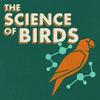134 episodes

Random Bird Thursday: A Worm-slurping Mud-runner From Siberia
2025-12-12 | 22 mins.
In each Random Bird Thursday (RBT) episode, the goal is to highlight a bird species that probably isn't going to get featured in a full-length podcast episode. These are birds we might overlook, even though they certainly deserve some appreciation and attention. ~~~~~~~~~~~~~~~~~⚠️ SPOILER ALERT!The featured species in this episode is the Asian Dowitcher (Limnodromus semipalmatus)Asian Dowitcher sounds (Xeno Canto recordings XC349045 and XC806613)Support the show

Herring Gulls
2025-12-04 | 46 mins.
👕 Bird Merch — Get yourself some bird shirts!~~~In this episode—which is number 126—Ivan Phillipsen heads to the seashore to explore the iconic Herring Gulls whose calls define the soundscape of coasts across North America and Europe. Listeners meet not just one but two species: the American Herring Gull and the European Herring Gull, nearly identical in appearance but with a surprisingly twisty evolutionary backstory.Ivan breaks down what makes these gulls such compelling birds: their “menacing” expressions, complex vocal repertoire, opportunistic diets (including bags of Doritos), and clever foraging tricks like dropping clams from the air and tap-dancing for earthworms. He also looks at how these gulls live and raise their young—forming long-term pair bonds, nesting in dense gulleries, and fiercely defending their territories in ways that some unlucky humans have experienced up close.Once persecuted, then booming, and now declining in some regions, these birds tell a story that’s far more complicated than being “just seagulls.”Links of InterestA Herring Gull “foot pattering” on grass [VIDEO]Link to this episode on the Science of Birds websiteEarlham College - A fantastic place to get an education, especially if you love birdsSupport the show

Random Bird Thursday: A Species with an Executioner’s Axe for a Face
2025-11-28 | 15 mins.
In each Random Bird Thursday (RBT) episode, the goal is to highlight a bird species that probably isn't going to get featured in a full-length podcast episode. These are birds we might overlook, even though they certainly deserve some appreciation and attention. ~~~~~~~~~~~~~~~~~⚠️ SPOILER ALERT!The featured species in this episode is the White-thighed Hornbill (Bycanistes albotibialis)White-thighed Hornbill sounds (Xeno Canto recording XC617118)Support the show

How Birds Breathe: The Avian Respiratory System
2025-11-18 | 38 mins.
👕 Bird Merch — Get yourself some bird shirts!~~~This is Episode 125. Host Ivan Phillipsen takes listeners inside the amazing respiratory system of birds. He starts by grounding the topic in familiar territory—how mammal lungs work—before revealing how different the avian system really is.The episode walks through the unique division of labor between birds’ small, rigid lungs and their large air sacs, and explains the elegant, one-way flow of air that keeps oxygen constantly moving across gas exchange surfaces.The episode also looks back in time, exploring how this respiratory design first evolved. Listeners will come away with a deeper appreciation of what’s happening inside every bird with each breath.Link to this episode on the Science of Birds websiteEarlham College - A fantastic place to get an education, especially if you love birdsSupport the show

Random Bird Thursday: A Sparrow-sized Drummer from the Neotropics
2025-11-06 | 18 mins.
In each Random Bird Thursday (RBT) episode, the goal is to highlight a bird species that probably isn't going to get featured in a full-length podcast episode. These are birds we might overlook, even though they certainly deserve some appreciation and attention. ~~~~~~~~~~~~~~~~~⚠️ SPOILER ALERT!The featured species in this episode is the Little Woodpecker (Veniliornis passerinus)Support the show
More Science podcasts
Trending Science podcasts
About The Science of Birds
Listen to The Science of Birds, Quirks and Quarks and many other podcasts from around the world with the radio.net app

Get the free radio.net app
- Stations and podcasts to bookmark
- Stream via Wi-Fi or Bluetooth
- Supports Carplay & Android Auto
- Many other app features
Get the free radio.net app
- Stations and podcasts to bookmark
- Stream via Wi-Fi or Bluetooth
- Supports Carplay & Android Auto
- Many other app features


The Science of Birds
download the app,
start listening.


































